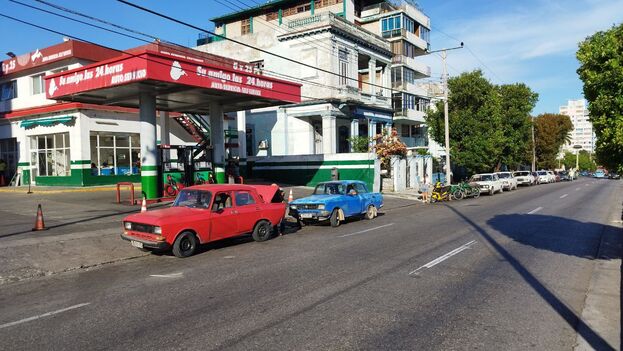
![]() 14ymedio, Juan Diego Rodríguez, Havana, October 27, 2022 — Two dilapidated Moskvich cars are at the head of the line at the service center on the corner of G and 25th streets in Havana. The driver of the first one, a red vehicle, pays for his fuel ration while an employee explains to customers that they cannot buy an extra gallon. “You’re only allowed to buy what fits in the tank,” she says adamantly. “Everyone knows that.”
14ymedio, Juan Diego Rodríguez, Havana, October 27, 2022 — Two dilapidated Moskvich cars are at the head of the line at the service center on the corner of G and 25th streets in Havana. The driver of the first one, a red vehicle, pays for his fuel ration while an employee explains to customers that they cannot buy an extra gallon. “You’re only allowed to buy what fits in the tank,” she says adamantly. “Everyone knows that.”
The second Moskvich, with a badly bruised body painted over in blue, is waiting its turn while the employee continues her warning, speaking loud enough for the other drivers to hear. “People don’t understand,” she says, “We’re almost out of fuel and, for today at least, we won’t be getting any more. That’s the way is.”
Forecasts by the state-owned Unión Cuba-Petróleo (Cupet) on Wednesday paint a discouraging picture. Given the “higher-than-usual demand ” and the “operational challenges” of transporting the gasoline from the Cienfuegos refinery, the fuel shortage is expected to continue.
The cars slowly inch along as Cupet employees wait on them without any sense of urgency. If you’re in a hurry, you cannot afford to wait in line at a gas station like this one. Almost twenty cars are parked in the street, waiting their turn.
Having both a full tank and some gas in reserve has become almost impossible in the capital. Drivers face two realities: either a service station is completely empty — a sign that it has not had gasoline in days — or the wait in line lasts many hours.
That’s how it is at the Tangana gas station between Calzada and N streets, where vehicles form three distinct side-by-side lines. No one can say how long the wait time is to get to the pump.
If you are willing to give them some of the fuel you buy, however, there are drivers who will let you cut in line, admits one driver waiting in this impossible queue, which winds its way around the block several times.
The most devastating outcome is driving to a service station and discovering you have wasted what little fuel you had getting there. With nothing to sell, the Cupet station at San Rafael and Infanta streets has been left completely open. The only business in operation on the site is the small side building, where the absence of a line signals that it too has nothing worth buying.
There are no cars at the Rampa station on 23rd and Malecon. In spite of its prime location at the gateway to Vedado, the government has not made any fuel deliveries here either.
The fuel shortage is making many daily tasks, such as delivering merchandise to produce markets and moving households, more chaotic and costly. According to 27-year-old Abel, member of a team which moves furniture and personal belongings from one dwelling to another, “the gas shortage has raised prices for customers and complicated the work” of his small business.
“Right now, the average move between two houses here in Havana, which takes a four-man crew, costs at least 20,000 pesos. And that price has a lot to do with the problems of buying fuel. That means we can’t do our job efficiently and, ultimately, it’s the customer who pays for that,” he says.
Abel’s team must confirm they can get diesel fuel for his truck several days in advance. And often customers must wait a bit longer so that the team can then confirm things with them. “We can’t tell them yes until we know we we’ll be able to fill the tank and we can never be sure of that,” he says. The black market is an option but, as he says, “being in a hurry is expensive. You don’t have to wait in line but you’ll feel it in your wallet.”
____________
COLLABORATE WITH OUR WORK: The 14ymedio team is committed to practicing serious journalism that reflects Cuba’s reality in all its depth. Thank you for joining us on this long journey. We invite you to continue supporting us by becoming a member of 14ymedio now. Together we can continue transforming journalism in Cuba.
